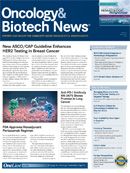ALK-Positive Criteria for Determining Crizotinib Use May Fall Short
The criteria that are presently used to determine whether patients with non-small cell lung cancer may be suitable for treatment with the ALK inhibitor crizotinib may overlook some patients who may benefit from the drug.
D. Ross Camidge, MD, PhD
The criteria that are presently used to determine whether patients with non-small cell lung cancer (NSCLC) may be suitable for treatment with the ALK inhibitor crizotinib may overlook some patients who may benefit from the drug, researchers report. In particular, they noted that borderline and atypical ALK-negative cases need closer scrutiny.
D. Ross Camidge, MD, PhD, University of Colorado Cancer Center in Denver, and associates tested 1426 NSCLC clinical specimens for ALK rearrangements.
Overall, 174 specimens were ALK-positive by conventional criteria and 1252 were ALK-negative.
Screening patients with advanced NSCLC for an ALK rearrangement has been adopted as standard care based on the “dramatic and prolonged” objective responses that have been documented when these patients are treated with ALK inhibitor therapy, such as the orally bioavailable crizotinib, the investigators observed. As a result, identifying subsets of patients who are most likely to benefit from such treatment is important.
ALK gene rearrangements are the “primary oncogenic driver” in some types of lymphomas and solid tumors, the researchers said. The ALK Break Apart FISH (fluorescence in situ hybridization) Probe Kit is the only ALK diagnostic assay that is approved by the FDA.
Preliminary data suggested that a cutoff point of ≥15% or >15% of cells demonstrating an ALK rearrangement by Break Apart FISH for classifying a tumor as ALK positive would yield few borderline cases, Camidge et al pointed out. The >15% cutoff point used in the early crizotinib studies and the ≥15% cutoff point used by the FDA “appeared to develop in a naturally occurring gap in the continuum of the assay.” However, the present “much larger series” indicates that “considerable proportions of ‘negative’ cases closely approach the established cutoff points,” they added.
Specifically, of the ALK specimens that were determined to be negative by standard criteria, 121 had ≥10% ALK positivity but were still less than the 15% level required in order to classify the tumor as ALK positive.
Overall, the findings show that 8.5% of tumors fall below the established positivity threshold by ≤5%, and are thus deemed “borderline negative.”
In addition, 1%-2% also demonstrated atypical negative patterns, meaning that they do not satisfy the current Break Apart assay positivity criteria but have evidence of potential complex rearrangements within the ALK locus, such as 3’ ALK doublets or single 5’ ALK.
Camidge and associates said that additional examination of ALK in such cases by other diagnostic approaches such as immunohistochemistry may be needed.
“By capturing clinical outcomes from atypical negative and borderline negative FISH cases in which the second diagnostic suggests the true presence of an activating rearrangement, it should be possible to minimize missed therapeutic opportunities among the true inhibitor-sensitive, ALK-positive population,” the authors reported.
Camidge DR, Skokan M, Kiatsimkul P, et al. Native and rearranged ALK copy number and rearranged cell count in non-small cell lung cancer: implications for ALK inhibitor therapy [published online ahead of print September 10, 2013]. Cancer. doi:10.1002/cncr.28311.




